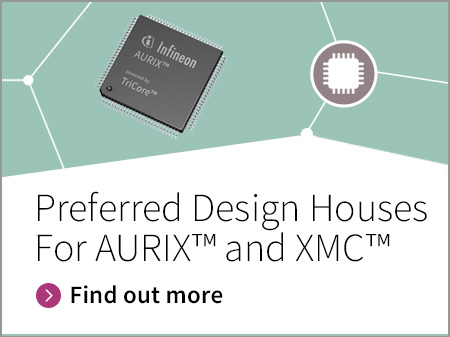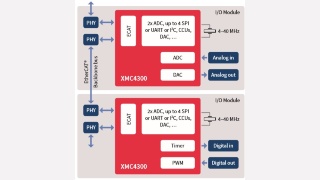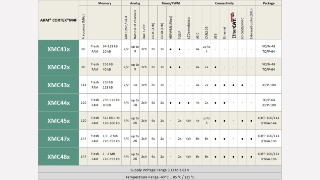XMC4300
Description:
The XMC4300 devices are members of the XMC4000 family of microcontrollers based on the Arm® Cortex®-M4 processor core. The XMC4300 combines the extended functionality and performance of the Arm® Cortex®-M4 core with powerful on-chip peripheral subsystems and on-chip memory units. The XMC4300 family of microcontrollers take advantage of Infineon's decades of experience in the industrial market to provide an optimized solution to meet the performance challenges of today's embedded control applications.
EtherCAT ® node on an Arm® Cortex®-M microcontroller with on-chip flash and analog/mixed signal capabilities with outstanding Flash to RAM ratio.
>See full portfolio and find related EtherCAT® kits
Summary of Features:
- 256 KB Flash, 128 KB Ram
- Supply voltage range: 3.13 - 3.63V
- USIC 4ch [Quad SPI, SCI/UART, I²C, I²S, LIN]
- 1x PWM Timers (CCU8), 16-64Bit 8ch + Dead-Time
- 2x CAN, 64 MO
- Peripherals Clock: 144 [MHZ]
- Core frequency: 144 [MHZ]
- EtherCAT
- Rich Industrial and External Media Connectivity
- Package: LQFP100
- Temperature range: -40°..... 85°/125°
- LED Matrix Control, (8x8 Segments)
- Long-term availability with >15 years
- Free ModusToolbox™ IDE and ModusToolbox Apps
Target Applications:
EtherCAT®
EtherCAT® is the real-time Ethernet standard for combining great bandwidth with unrivaled isochronous time determinism in ranges of three-digit down to low two-digit nanoseconds. The XMC4300 and XMC4800 series are the industry's first-ever microcontrollers with EtherCAT® integrated on a standard Arm® Cortex®-M4 controller with integrated flash memory and analog/mixed signal IP. This provides the most compact and cost-efficient EtherCAT® design without a dedicated ASIC, external memory and crystal.
- Guaranteed availability through 2031 or longer
- Pin and code compatibility with the established XMC4000 microcontroller family
I/O modules
Sense, control, drive, communicate - these tasks are versatile and complex on the field level, but there is a perfect I/O module for every dedicated task. Typically, I/O modules form compact in size, thereby providing limited PCB space, but are demanding in relation to the microcontroller features needed to fulfill their tasks. In the event that the backbone bus requires more bandwidth than CAN or serial communication can provide, the XMC4300 is the right choice.
| Parametrics | XMC4300 |
| A/D Input Lines (incl. FADC) | 14 |
| Additional Features | USB SD/MMC ; Ethernet 10/100 Mbit/s ; EtherCAT® |
| CAN Nodes | 2 |
| Clock Frequency max | 144.0 MHz |
| DMA Channels | 8 |
| DSP Functionality | yes |
| Digital I/O Pins | 75 |
| EEPROM Emulation | yes |
| External Bus Interface | no |
| Fast Flash Programming | no |
| FlexRayTM | no |
| Floating Point Unit | yes |
| I/O Operation Voltages | 3.3 V |
| Instruction Set Architecture | ARM® Cortex™-M4 (32-bit) |
| Instruction Width ([bits]) | 32/16 |
| Number of ADC Modules | 2.0 |
| On-chip Clock Generation | yes |
| On-chip Voltage Regulator | yes |
| Oscillator Watchdog | yes |
| Peripheral Control Processor | no |
| Power Mode | clock gating possible |
| Program Memory | 256.0 kByte |
| Qualification | Industrial |
| Real Time Clock | yes |
| SRAM (incl. Cache) | 128.0 kByte |
| Serial I/O Interfaces | 4 |
| Temperature | -40 to 85°C/125°C |
| Timed I/O Pins (PWM, CAPCOM) | 16 |
| Timer/Counter | 12 |
| Touch/LED Matrix Control | yes |
| Type of Memory | Flash |
| Type of Serial I/O Interfaces | UART I²C ; I²S ; SPI |
| Watchdog Timer | yes |








